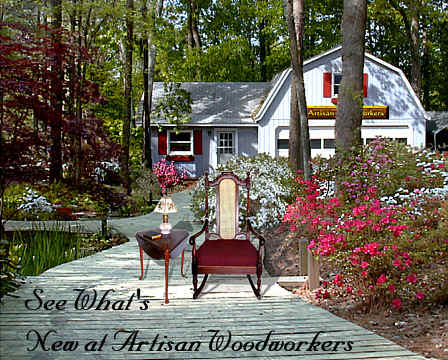
 |
Glossary of Terms,
Antique Furniture
H
H-stretcher: Typical stretcher construction, as in some Windsor and Chippendale chairs. A stretcher from front to back leg on each side is connected through the middle by a third member.
Hadley Chest: Early American chest, first found in Hadley, Mass. Typical tulip carving over front rails as well as the three panels; often with a drawer.
Haircloth: Fabric woven of horsehair, colored, or small-figured, typical of mid-19th Century upholstery. A mixture of horsehair and linen was used by the 18th Century English.
Half Column: An architectural column split in half, and fastened to edges of highboys, cabinets, and secretaries, in the same manner as a pilaster.
Half-Turning: Turned members sawed in half, lengthwise, usually applied to a flat surface as ornament, particularly in English and American Jacobean, Italian, and German Renaissance. Also used as spindles in Jacobean chairs with the smooth side to the sitter's back.
Hall Tree: A tall metal or wood framework with "branches" to hang hats, coats, etc.; sometimes with umbrella rack at the base.
Harvest Table: Long, narrow rectangular table with hinged drop-leaf sides, straight legs.
Hasp: Hinged portion of a hinge lock.
Haut Relief: French name for a deep carving.
Headboard: Simple panel at the head of the bed.
Herringbone: Inlay banding in which the alternately slanting grain produces a chevron or herringbone effect.
H-Hinge: One with exposed, long flat leaves that opened to resemble the letter H.
Highboy: Tall chest of drawers, usually in two sections, the upper chest being carried on a tablelike structure or lowboy with long legs. The form is English.
Hitchcock: The Hitchcock chair is an American type, 1820-1850, named after Lambert Hitchcock of Connecticut. The typical form derives from a Sheraton "fancy" Chair, and has a typical "pillow back" or oval turned top rail, straight-turned front legs, a ruch or caned seat enclosed in thin wood strips. Most often these were painted to simulate rosewood, with a unique powered-gold stencil of fruit and flowers.
Hood: Shaped top, usually curved, on a highboy, clock case, etc.
Hoop Back: Chair back whose uprights and top rail form a continuous curve.
Horseshoe Back: In Windsor chairs, outward sweep at the base of the bow of the back.
Huntboard: Generally of Southern origin, a long, high sideboard table of shallow depth; in basic form simply a board or frame from which one served drinks to a group after the fox hunt.
Hutch: From the French huche. A chest or cabinet with doors, usually on legs. An early form descending from the Gothic and disappearing after the 17th Century.
